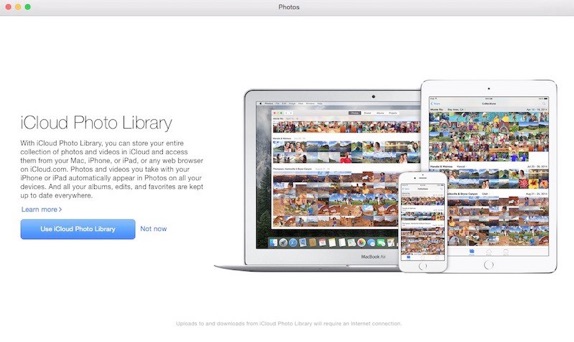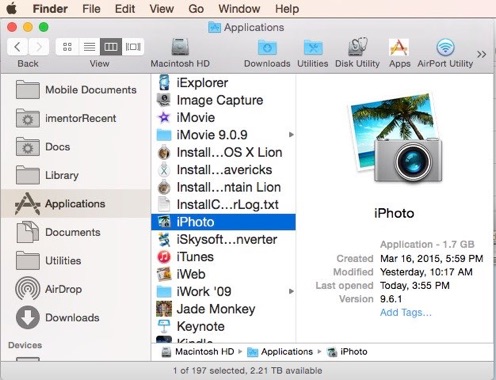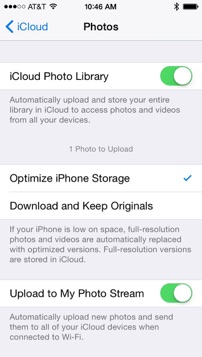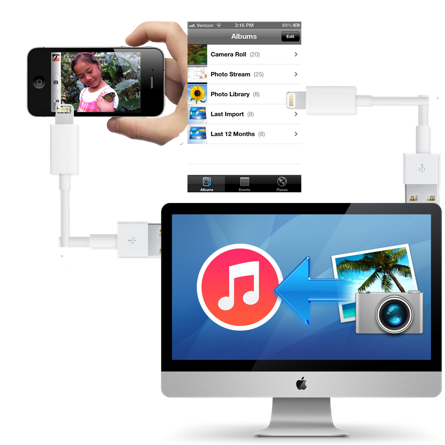On April 8, 2015 Apple released
the Macintosh OS X 10.10.3
Yosemite update.
This release added a new application
called Photos.
The iPhoto icon in the Dock was
replaced with the new Photos icon.
When Photos was run it offered to convert the iPhoto library to Photos.
If the conversion was allowed, a new Photos library was created.
The existing iPhoto library was not modified.
Also, Photos became the default iLife photo app.
During the first run of Photos the user was also offered to activate
iCloud Photo Library.
iCloud Photo Library automatically uploads and stores the entire
Photos library to the user’s iCloud account.
This gives access to the entire library of photos and videos to
all Apple devices and the Internet.
Also, Photo Stream no longer works on the Mac and is replaced
with a full sync of your entire library.
Furthermore, iTunes sync of photos from the computer to mobile devices
is disabled if iCloud Photo Library is enabled on the mobile device.
iCloud Photo Library occupies available space in the user’s iCloud account.
Apple gives each iCloud user 5GBs of storage for free.
My Photos library is 40GBs. That means i had to buy more iCloud storage
in order to participate in iCloud Photo Library.
i had to buy the 200GB plan for $3.99 per month (that’s $47.88 per year).
Photos changes the look and feel of your photo library.
Some features in iPhoto are now missing in Photos:
Star ratings are replaced with favorite hearts.
Mailing photos can no longer be done within the Photos app,
but are handed off to Apple Mail app.
(this is actually a good thing, since the internal iPhoto mailing system
never worked well).
Flickr and Facebook syncing tools require more work to accomplish.
Geotagging is gone.
All video editing must now be done in iMovie.
The photo library is only sorted by date.
Albums can still be manually arranged by dragging, but the only other
automatic sort is by title.
Projects are turned into albums.
Some users will not want to change from iPhoto.
For them, there are a couple of obstacles.
To continue using iPhoto you must have the 9.6.1 version.
This update (from 9.6.0) had to have been done before upgrading to
10.10.3 Yosemite.
If the user neglected to update iPhoto it can be done, in most cases,
by placing iPhoto in the trash, then go to App Store > Purchases > iPhoto>
click on the Install button.
If this method is not available, you must find someone like me
who has a copy of iPhoto 9.6.1 and install it manually.
Once you have a working copy of iPhoto, running it will warn you
that your iPhoto library has already been migrated to the Photos app.
Choose “Open library in iPhoto.”
You can continue to use iPhoto, iTunes sync and Photo Stream
as long as Apple still supports them.
If you enabled iCloud Photo Library, you must disable it for some
legacy features to work.
Be aware that changes you make to the iPhoto library do not occur
in the Photos library.
Likewise, changes you make to the Photos library do not occur
in the iPhoto library.
Pick one.
i believe in moving ahead with Apple technology as it evolves.
i migrated iPhoto to Photos.
On my desktop Mac (in Photos > Preferences) i opted to enable
iCloud Photo Library.
i selected “Download Originals to this Mac” so that my photo library
is stored on the Mac and backed up to Time Machine.
On my iPhone (and other mobile devices) i chose to
“Optimize iPhone Storage."
Optimizing iPhone Storage places small photo thumbnails on the iPhone
to save phone storage.
When editing photos, the full sized version is downloaded to the iPhone.
This also occurs when you email or share a photo from the iPhone.
Before iCloud Photo Library, users would fill their iPhone camera rolls
with photos and videos.
This also filled their free 5GBs of iCloud backup space.
One of the hardest procedures to teach users was the round trip of a photo
(or video) from taking it with the iPhone to putting it back on the iPhone.
The procedure was to
take the picture,
connect the iPhone with a USB cable to a computer,
import the photos into iPhoto,
erase the camera roll,
organize photos into albums in iPhoto,
open iTunes,
check off the iPhoto albums you want on the iPhone,
then sync the photos from computer to iPhone with iTunes.
Now, i take a picture with a mobile device and it appears instantly
on my computer and all my other devices. If i add a photo to Photos
on my Mac, it instantly appears on all devices as well.
It is inevitable that most Apple users will make the transition to Photos app.
In the meantime, iPhoto, Adobe Lightroom, Dropbox, Picasa and the new
Google Photos are good alternatives.
First look at Google Photos is very impressive.
Not surprisingly, the photo search functions are awesome.
Other features are instant movies, animated gifs
and grouping buy facial recognition and scenic details.
The nature of a collection is that it is all in one place.
Choose a photo collection method and stick to it.







Photos vs iPhoto
Saturday, June 6, 2015









weekly hint and rant #331
Click here for
this week’s music

714-728-3224
949-734-0056










 |































































































































